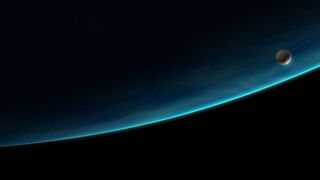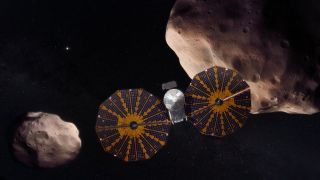Do Trojan exoplanets exist?
Investigating these co-orbiting worlds in our own solar system may help us predict prevalence in extrasolar systems.

Co-orbiting worlds, also known as Trojans, have not been found yet outside the solar system. That's a strange thing, a new study suggests, given we see them constantly closer to home.
Our solar system is full of Trojans; the asteroids orbit the sun along the same path as a larger planet (like Jupiter) about 60 degrees ahead of and behind the planet. But it might be that tidal forces alter the orbits of larger worlds, like an exoplanet.
While exoplanets with Trojan orbits may form, the study led by the SETI (Search for Extraterrestrial Intelligence) Institute suggests that the larger worlds with short-period orbits get thrown out of their path due to gravitational forces from the nearby star. Once ejected, the Trojan collides with either the star or a larger planet.
Related: Earth has an extra companion, a Trojan asteroid that will hang around for 4,000 years
The study has implications for our current catalog of 5,000 exoplanets, which mostly include those worlds that are close to their parent stars because they are easier to detect (either because they are easier to view as they move across a star from our perspective, or because their gravitational tug is a bit stronger on the star.)
In other words, Trojans might be out there, but not yet detectable with current techniques. Alternatively, Trojans might be removed from their systems quite quickly compared to the relative age of the universe, making them harder to spot.

Earthlings experience tidal friction because of the interaction between the Earth and the moon, SETI pointed out in a press release. The tides slow Earth's rotation and cause the moon to move further away from the Earth.
Get the Space.com Newsletter
Breaking space news, the latest updates on rocket launches, skywatching events and more!
The new study generalizes this friction to theoretical exoplanet systems with more than two bodies, assuming a star, a gas giant planet and a rocky planet moving around Lagrange points, or gravitationally stable areas between multiple worlds.
The analysis suggests that the star's tides and the giant planet's tides working together on the Earth-sized planet would make its orbit become unstable. Oscillations in the small planet's orbit, the release stated, would "change from oval-shaped to banana-shaped and ultimately break out of the shared orbit, colliding with either the star or the giant planet."
While the tidal forces may eject Trojans before we can observe them, there might still be some that are in younger systems and able to be observed. There also might be more insight on how Trojans behave from a NASA mission in flight. Lucy launched last October to look at Trojan asteroids up close, which is a first.
A study based on the research was available in pre-proof on Icarus May 21. It is led by Anthony Dobrovolskis, a research scientist at the SETI Institute.
Follow Elizabeth Howell on Twitter @howellspace. Follow us on Twitter @Spacedotcom and on Facebook.
Join our Space Forums to keep talking space on the latest missions, night sky and more! And if you have a news tip, correction or comment, let us know at: community@space.com.

Elizabeth Howell (she/her), Ph.D., is a staff writer in the spaceflight channel since 2022 covering diversity, education and gaming as well. She was contributing writer for Space.com for 10 years before joining full-time. Elizabeth's reporting includes multiple exclusives with the White House and Office of the Vice-President of the United States, an exclusive conversation with aspiring space tourist (and NSYNC bassist) Lance Bass, speaking several times with the International Space Station, witnessing five human spaceflight launches on two continents, flying parabolic, working inside a spacesuit, and participating in a simulated Mars mission. Her latest book, "Why Am I Taller?", is co-written with astronaut Dave Williams. Elizabeth holds a Ph.D. and M.Sc. in Space Studies from the University of North Dakota, a Bachelor of Journalism from Canada's Carleton University and a Bachelor of History from Canada's Athabasca University. Elizabeth is also a post-secondary instructor in communications and science at several institutions since 2015; her experience includes developing and teaching an astronomy course at Canada's Algonquin College (with Indigenous content as well) to more than 1,000 students since 2020. Elizabeth first got interested in space after watching the movie Apollo 13 in 1996, and still wants to be an astronaut someday. Mastodon: https://qoto.org/@howellspace
Most Popular


